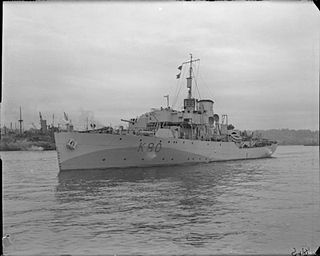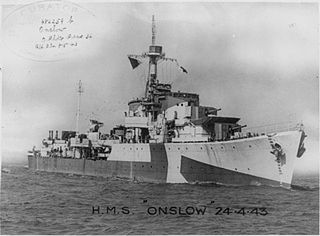
HMS Bluebell was a Flower-class corvette that served in the Royal Navy in World War II. Ordered from Fleming & Ferguson of Paisley, Scotland on 27 July 1939, she was launched on 24 April 1940 and commissioned in July 1940. She served in the Atlantic, Mediterranean and Arctic campaigns, escorting several convoys to Russia, and also took part in the invasions of Sicily and France. She was torpedoed and sunk by U-711 in the Kola Inlet on 17 February 1945 while escorting the convoy RA 64 from Murmansk. Only one member of her crew survived.
During the Second World War, designated convoy rescue ships accompanied some Atlantic convoys to rescue survivors from ships that had been attacked. Rescue ships were typically small freighters with passenger accommodation converted to rescue service. This involved enlarging galley and food storage areas and providing berthing and sanitary facilities for approximately 150 men. Preparation for service included the installation of scrambling nets along the sides, and the substitution of boats suitable for open sea work for normal lifeboats. Rescue ships normally included a small operating room for an embarked naval doctor and sick bay staff.

HMS Bergamot was a Flower-class corvette that served in the Royal Navy.

HMS Onslow was an O-class destroyer of the Royal Navy. The O-class were intermediate destroyers, designed before the outbreak of the Second World War to meet likely demands for large number of destroyers. They had a main gun armament of four 4.7 in guns, and had a design speed of 36 kn. Onslow was ordered on 2 October 1939 and was built by John Brown & Company at their Clydebank, Glasgow shipyard, launching on 31 March 1941 and completing on 8 October 1941.
Convoy PQ 1 was the second of the Arctic Convoys of World War II by which the Western Allies supplied material aid to the Soviet Union in its fight with Nazi Germany. The convoy sailed from Hvalfiord in Iceland on 29 September 1941 and arrived at Archangelsk on 11 October 1941.
Convoy PQ 3 was the fourth of the Arctic Convoys of World War II by which the Western Allies supplied material aid to the Soviet Union in its fight with Nazi Germany. The Convoy sailed from Hvalfjord, Iceland on 9 November 1941 and arrived at Archangelsk on 22 November 1941.
Convoy PQ 4 was the fifth of the Arctic Convoys of World War II by which the Western Allies supplied material aid to the Soviet Union in its fight with Nazi Germany. The Convoy sailed from Hvalfjord, Iceland on 17 November 1941 and arrived at Archangelsk on 28 November 1941.

Convoy PQ 5 was the sixth of the Arctic Convoys of World War II by which the Western Allies supplied material aid to the Soviet Union in its fight with Nazi Germany. The Convoy sailed from Hvalfjord, Iceland on 27 November 1941 and arrived at Archangelsk on 13 December 1941.
SS River Afton was a steam merchant built in 1935 by Lithgows, of Port Glasgow, Scotland and homeported in Glasgow. She was operated by Campbell Brothers & Co, Newcastle-upon-Tyne. She was named after the River Afton in Ayrshire, Scotland.
Convoy PQ 6 was the seventh of the Arctic convoys of World War II by which the Western Allies supplied material aid to the Soviet Union in its fight with Nazi Germany. The convoy sailed from Hvalfjörður, Iceland, on 8 December 1941 and arrived at Murmansk on 20 December 1941.
Convoy PQ 7 was the eighth of the Arctic convoys of the Second World War by which the Western Allies supplied material aid to the Soviet Union in its fight with Nazi Germany. The convoy was in two parts: PQ 7a sailed from Hvalfjörður, Iceland on 26 December 1941 and arrived at Murmansk on 12 January 1942. PQ 7b sailed from Hvalfjord, Iceland on 31 December 1941 and arrived in Murmansk on 11 January 1942.

Convoy PQ 15 was an Arctic convoy sent from Iceland by the Western Allies to aid the Soviet Union during the Second World War. The convoy sailed in late April 1942, reaching the Soviet northern ports after air attacks that sank three ships out of twenty-five.
Convoy PQ 12 was an Arctic convoy sent from Great Britain by the Western Allies to aid the Soviet Union during World War II. It sailed in March 1942, reaching Murmansk despite a sortie against it by the German battleship Tirpitz. All ships arrived safely.
Convoys PQ 9 and 10 were Arctic convoys sent from Great Britain by the Western Allies to aid the Soviet Union during World War II. They sailed together in early February 1942 and arrived in Murmansk without loss.

Convoy PQ 8 was an Arctic convoy sent from Great Britain by the Western Allies to aid the Soviet Union during World War II. It sailed in January 1942 and arrived in Murmansk with the loss of one escort sunk, and one ship damaged.

QP 14 was an Arctic convoy of the QP series which ran during World War II. It was one of a series of convoys run to return Allied ships from Soviet northern ports to home ports in Britain. It sailed in September 1942 from Archangel in Russia to Loch Ewe in Scotland.

HMS Sharpshooter was a Halcyon-class minesweeper of the British Royal Navy. Built at Devonport Dockyard, Sharpshooter was completed in 1937. She served through the Second World War, acting both in her designed role as minesweeper and as a convoy escort, escorting several Arctic convoys. She took part in the evacuation from Dunkirk in 1940, and sank the German submarine U-655 in 1942.
Convoy QP 1 was an Arctic convoy of the PQ/QP series which ran during the Second World War. It was one of a series of convoys run to return Allied ships from Soviet northern ports to home ports in Britain. It sailed in late September 1941, reaching Allied ports in mid-October. All ships arrived safely.

HMS Dianella was a Flower-class corvette of the Royal Navy. She served during the Second World War.
SS Hartlebury was a cargo steamship that was launched in Scotland in 1934 for J&C Harrison Ltd. A U-boat sank her in the Barents Sea in 1942 when Hartlebury was a member of the Arctic convoy Convoy PQ 17.








